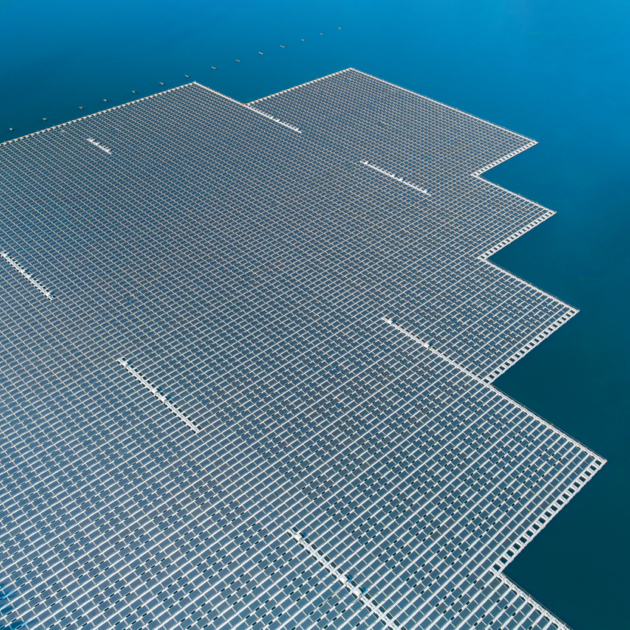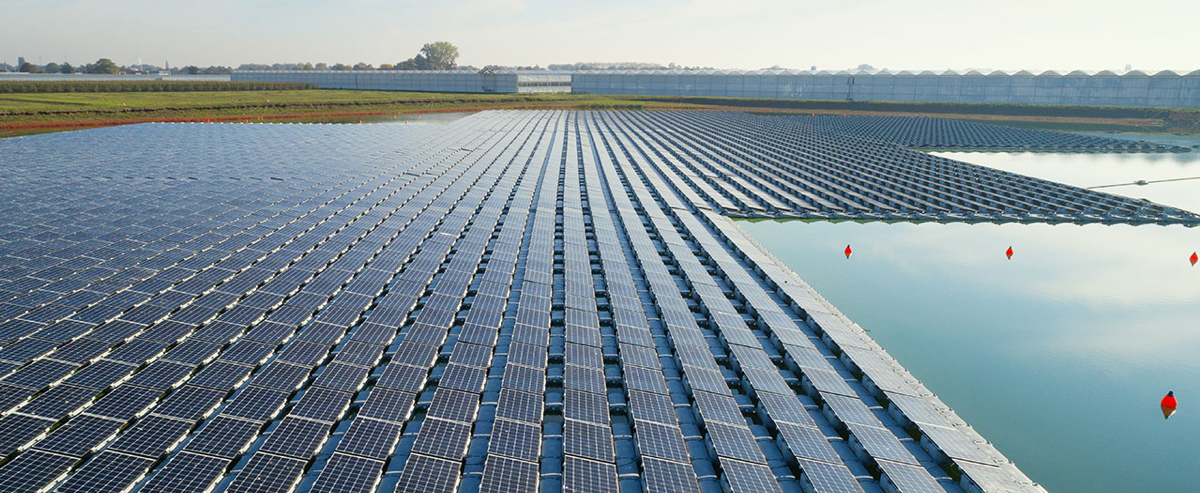As the global race to net zero accelerates, the spotlight has shifted onto innovative and space-efficient renewable energy solutions. One such rising star is floating solar, the deployment of solar photovoltaic (PV) panels on bodies of water, from reservoirs to offshore platforms.
What began as a novel concept is rapidly transforming into a critical pillar of sustainable energy strategy, especially when paired with wind farms, both fixed and floating. But how viable is this combination, and what does the future hold across regions such as the UK, Southern and Northern Europe, and the Nordic countries?
What is Floating Solar?
Floating solar, also known as floatovoltaics – involves installing solar arrays on water surfaces, most commonly lakes, reservoirs, and increasingly, the ocean. These systems are typically mounted on buoyant platforms that tether the panels in place, allowing them to follow the sun while staying stable against wind and wave forces.

The Pros: Why Floating Solar is Making Waves
-
1. Efficient Use of Space
Land scarcity is a key constraint for many renewable projects. Floating solar offers a clever workaround by utilising underused water surfaces, especially near urban areas or industrial sites.
-
2. Improved Panel Efficiency
Water naturally cools the solar panels, boosting their efficiency compared to land-based systems. In some instances, gains of 5–15% have been reported.
-
3. Synergy with Hydropower and Wind Farms
Combining floating solar with hydropower dams or offshore wind farms creates hybrid energy systems that can maximise output while smoothing fluctuations. Floating solar can fill in during low-wind periods, making energy delivery more consistent.
-
4. Reduced Evaporation
Particularly in Southern Europe, placing panels on water bodies can reduce evaporation – a valuable co-benefit in water-scarce regions.
-
5. Minimal Land Disruption
Floating solar leaves terrestrial ecosystems untouched, an appealing trait in densely populated or agriculturally important areas.
The Cons: Calm Waters or Hidden Depths?

-
1. Higher Installation and Maintenance Costs
Marine environments are harsher on equipment, with salt corrosion, biofouling, and strong wave action adding to maintenance demands. This can raise the cost compared to land-based solar.
-
2. Environmental Risks
There are concerns over how floating solar may affect aquatic ecosystems, from reduced light penetration to changes in water temperature and oxygen levels. Careful environmental assessments are critical.
-
3. Grid Connection Challenges
Offshore installations, particularly those far from the coast, require robust subsea cabling and grid infrastructure, which can be expensive and complex.
-
4. Weather Dependency
Just like land-based solar, floating solar depends on sunshine. In Northern Europe and the Nordic region, where sunlight hours are limited in winter, output can be seasonal.
Floating Solar Meets Wind: A Dynamic Duo?
The pairing of floating solar with wind farms – especially offshore wind – is gaining traction. Offshore wind already benefits from established marine infrastructure. Co-locating floating solar on these sites allows shared grid connections, maintenance vessels, and substations, reducing overall costs and improving returns on investment.
In fixed offshore wind farms (where turbines are anchored to the seabed), there is space between turbines that can accommodate floating solar arrays. Floating wind farms, on the other hand, offer more dynamic positioning possibilities, allowing both technologies to “float” in harmony, potentially far from shore where land use is not a concern.
This hybrid approach is particularly promising in areas where wind and sun peak at different times. For instance, wind often blows stronger at night or during storms, while solar dominates during calm, sunny days, creating a complementary generation profile.
Regional Viability: Where Does Floating Solar Fit Best?
United Kingdom
The UK’s ambitious offshore wind strategy positions it perfectly for integrating floating solar. Though its cloud cover and northerly latitude limit solar output compared to sunnier climates, combining floating solar with wind farms could enhance grid stability and reduce intermittency.
Southern Europe
Countries like Spain, Italy, and Greece boast high solar irradiance and growing energy needs. Floating solar here can reduce evaporation from reservoirs and align well with existing hydropower infrastructure.
Northern Europe
Northern nations, including Germany and the Netherlands, are exploring floating solar on inland water bodies like canals and reservoirs. The synergy with wind is especially attractive in places like the North Sea, where vast wind farms already operate.
Nordic Region
While lower solar irradiance may limit seasonal output, the Nordics are strong candidates for hydro-solar hybrids. Floating solar on hydropower reservoirs allows shared grid connections and enhances flexibility in water management.
The Cons: Calm Waters or Hidden Depths?
Floating solar is reaching a tipping point. As more projects are developed, costs are falling thanks to economies of scale, supply chain efficiencies, and improved materials. Joint projects with wind or hydropower further enhance the financial case by sharing infrastructure.
Larger platforms also allow for automation in cleaning, monitoring, and maintenance, reducing operational costs. Some developers are exploring modular systems that can be scaled up or down depending on demand, water conditions, or seasonal factors.
Environmental Impact: Balancing the Equation
Positive Impacts
- Reduces pressure on land and terrestrial biodiversity.
- Prevents water evaporation and algae growth in reservoirs.
- Can repurpose man-made or industrial water bodies like flooded quarries or mine pits.
Negative Impacts
- Shading may affect aquatic ecosystems and hinder photosynthesis.
- Anchoring systems can disrupt sediment and benthic habitats.
- Risk of contamination if materials degrade into the water over time.
Environmental impact assessments, adaptive management, and robust monitoring are essential to ensure these systems contribute positively to climate goals without causing new problems.
Companies Leading the Charge
One notable UK-based pioneer is Offshore Solar Ltd, which is developing large-scale floating solar solutions tailored for co-deployment with offshore wind farms. Their innovative mooring systems and modular designs aim to make floating solar commercially viable even in challenging marine environments.
Other key players globally include:
- Ocean Sun (Norway): Focused on nearshore and offshore floating solar with membrane-based designs.
- Ciel & Terre (France): One of the earliest adopters of large-scale floating solar, with projects across Europe and Asia.
- BayWa r.e. (Germany): Investing heavily in inland floating solar installations in the Netherlands and beyond.
Final Thoughts: A Floating Future?
Floating solar is no longer just a niche innovation, it’s becoming a cornerstone of a diversified, resilient renewable energy system. When paired with offshore wind or hydropower, the benefits multiply, making it an attractive proposition across Europe and beyond. However, environmental caution and regulatory support must go hand-in-hand with technological progress.
As companies like Offshore Solar Ltd push boundaries and more hybrid projects come online, we may well be entering a new era, one where solar doesn’t just rise in the east, but floats with the tide.
The post Floating Solar: A Buoyant Future for Green Energy? first appeared on Haush.
